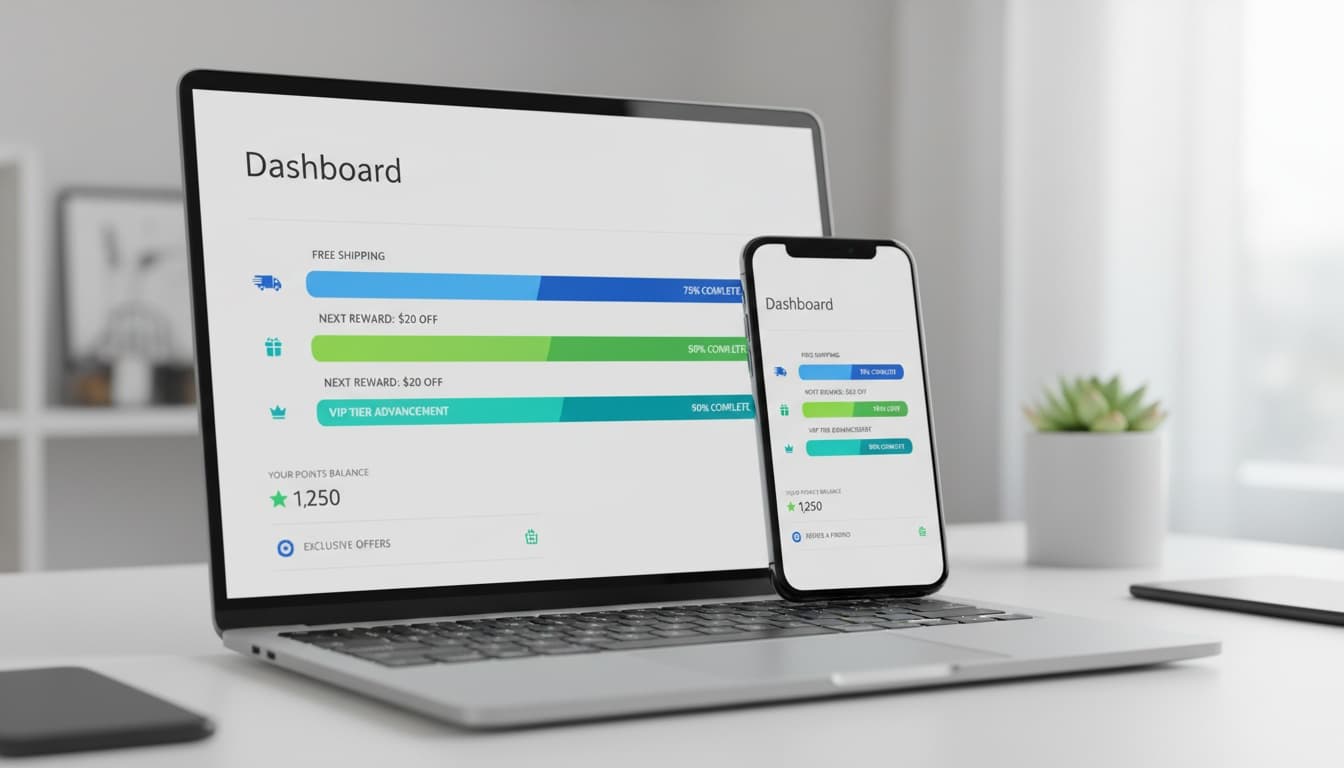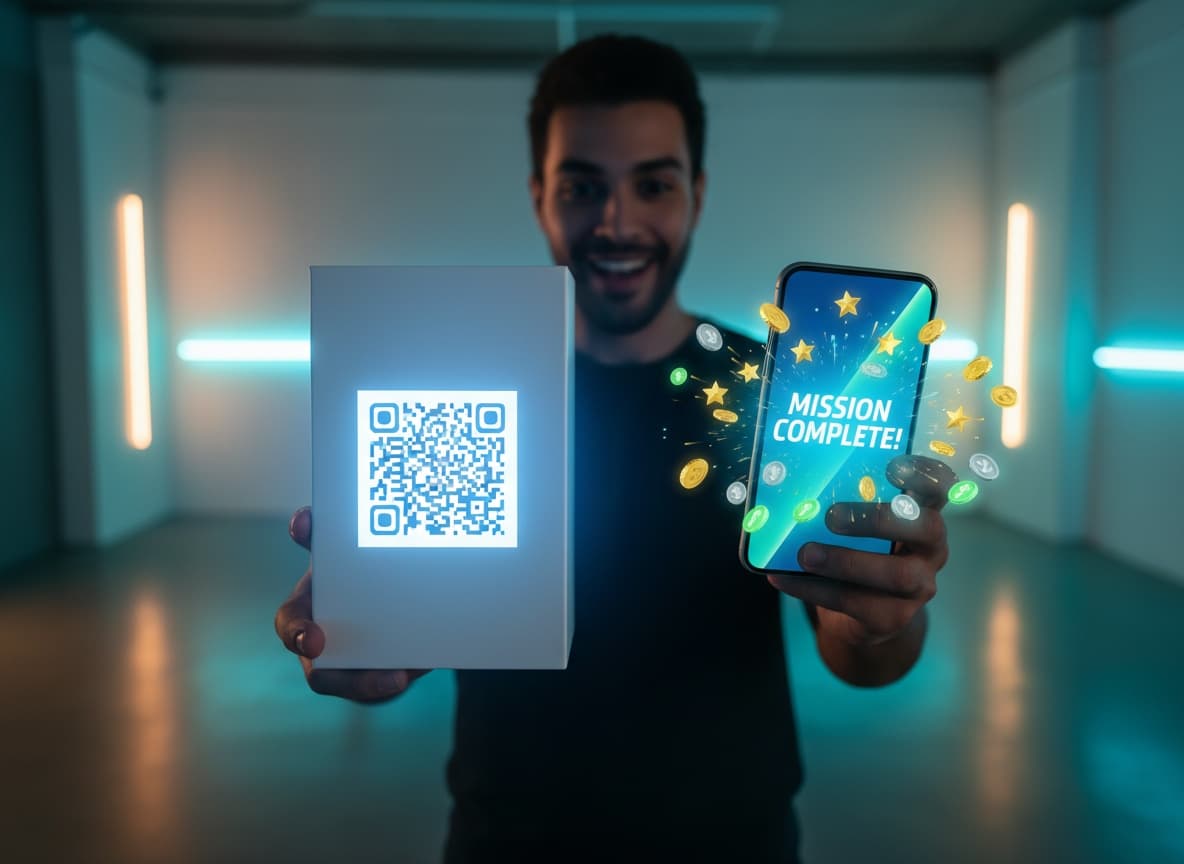Gamification turns your e-commerce store into an environment where every action feels like progress. Instead of shoppers visiting once and disappearing, they see levels, streaks, surprise rewards, and quests that invite them to come back. When done well, gamification increases time on site, boosts conversion, and encourages repeat purchases without depending only on discounts.
This guide shares practical e-commerce gamification ideas that increase sales, including progress bars, streaks, challenges, quests, bundles, surprise boxes, checkout gamification, product discovery loops, wheel spin mechanics, and QR triggered missions in offline packaging. For each tactic you will see how it works, why it works psychologically, and how to connect it to your rewards and QR journeys.
Turn your e-commerce store into a game that sells
Use progress bars, missions, and QR triggered rewards to make every visit and purchase feel rewarding.
Why gamification works in e-commerce
Gamification uses familiar game elements such as points, levels, and missions to change behavior in a non gaming context. In e-commerce it taps into core psychological drivers like progress, curiosity, social proof, and loss aversion. Customers who see visible progress are more likely to continue, and customers who feel close to a reward are more likely to place another order or add one more item to the cart.
Modern shoppers live inside gamified environments. Social apps, fitness trackers, and streaming platforms all use streaks, badges, and limited time challenges. When your store uses similar patterns, the experience feels intuitive and engaging. The goal is not to turn your brand into a video game but to gently guide behavior with clear feedback and meaningful rewards.
Gamification becomes even stronger when combined with loyalty programs and QR journeys. Points, tiers, missions, and scan based rewards can all run inside the same system, so customers feel one continuous game rather than disconnected promotions supported by short term discounts.
Progress bars that motivate completion
Progress bars are simple but powerful. They show customers how close they are to achieving a target, such as unlocking a discount, reaching free shipping, completing a profile, or finishing a challenge. Seeing 80 percent complete creates an urge to finish the last 20 percent.
In e-commerce, progress bars work especially well for cart thresholds. Show a bar that fills as customers add items, with a clear message such as spend twelve more dollars to unlock free shipping. You can also use progress bars inside a loyalty dashboard to show how close customers are to the next tier or reward. The visual cue reduces cognitive load and makes goals feel concrete.
Combine progress bars with QR interactions by letting offline scans push the bar forward. For example, scanning a QR code on packaging could give a small boost toward the next reward tier, making unboxing feel like part of the same journey that customers see in their online account.

Streaks that reward consistent behavior
Streaks reward customers for repeated behavior over consecutive days or weeks. Fitness apps use daily goals, while learning apps use streak counts to keep people coming back. In e-commerce you can design streaks for visits, engagement, or purchases depending on your vertical.
For example, you could reward customers who log in or browse a collection multiple days in a row, who scan QR codes from packaging each week, or who place several orders in a month. Streaks can unlock bonus points, temporary multipliers, or unique badges in your loyalty system.
To avoid pressure or burnout, allow streak recovery. Customers might spend a small amount of points to repair a broken streak or receive a second chance mission. This keeps the mechanic positive instead of punishing and aligns with long term loyalty rather than short term obsession.
Challenges and quests that drive repeat visits
Challenges and quests bundle actions into a short narrative. Instead of asking customers to complete isolated tasks, you present a clear list such as complete your profile, explore the new collection, scan your packaging, and place one order this month. Completing the quest unlocks a package of rewards that feels more meaningful than a single coupon.
Design quests around product discovery or seasonal campaigns. For a new collection, you might challenge customers to view three highlight products, add one item to a wishlist, and scan a QR code printed in the lookbook. For a replenishable category, you might build a monthly care quest that encourages customers to reorder on time, review products, and share feedback.
Quests work because they create structure. Customers know exactly what to do and what they will gain. They also create a sense of story, which is more memorable than isolated tasks. You can manage and track these flows through a unified engagement platform such as VISU solutions for retail and e-commerce, which connects visits, scans, and rewards.
Bundles and surprise boxes that feel like loot
Bundles and surprise boxes use randomness and perceived value to drive higher order values. Instead of buying individual items, customers purchase a curated set or a mystery box with guaranteed minimum value. The excitement of discovery and the feeling of winning more than you paid for are powerful motivators.
To keep trust high, define clear expectations. Communicate the product categories included, the minimum retail value, and any limitations on sizes or preferences. You can also create themed boxes such as starter kits, seasonal editions, or limited collaborations for your most loyal segments.
Gamify bundles by linking them to challenges. Completing a quest might unlock the right to buy a limited surprise box, or scanning a QR insert in a previous box might give early access to the next one. This turns surprise boxes into recurring events in your loyalty calendar rather than one off promotions.

Checkout gamification and cart completion nudges
Checkout is a critical moment where small gamified elements can prevent abandonment and increase average order value. Progress indicators, friendly milestones, and instant rewards all help customers feel they are finishing something valuable instead of just paying.
At checkout you can display a small progress bar for perks such as free shipping, free gifts, or tier points. You can also show limited time missions like add one more item from this category to unlock a bonus. These prompts should be subtle and relevant so they do not create friction.
You can also add lighthearted micro games that appear after successful payment, such as a quick spin to reveal a reward for the next order. The key is to place the game after confirmation to avoid distracting from conversion. The prize might be bonus points, a small credit, or a special mission that brings the customer back within a defined time window.
Product discovery loops that feel like exploration
Gamified product discovery turns browsing into exploration. Instead of scrolling through endless grids, customers see guided tours, collection checklists, and missions such as find three items you love in the new drop. Completing these loops gives them points or entries into a draw.
You can create discovery maps that highlight specific categories or themes. For example, a skincare brand might design a routine builder where customers unlock badges for exploring cleansers, serums, and moisturizers. A fashion brand might create a look creator mission where customers assemble outfits, save them, and share them with friends.
These loops work because they reduce choice overload. Customers know what to look at next and feel rewarded for exploration, which leads to better matching between needs and products. Over time, the data from these interactions helps you personalize recommendations, which creates another layer of engagement.
Wheel spin mechanics and instant rewards
Wheel spin mechanics are a popular form of instant gratification. Customers spin a digital wheel to receive a random reward such as a discount, free gift, or bonus points. This works well at key moments such as first visits, campaign launches, or post purchase confirmations.
To keep wheel spins profitable, control the probability of high value rewards and place reasonable limits on participation. The visual design should be polished and aligned with your brand. Avoid aggressive pop ups that appear too early or too often, which can feel spammy instead of fun.
Wheel spins are particularly effective when connected to loyalty data. For example, high value customers might have access to a premium wheel with better rewards, while new visitors receive smaller but still exciting prizes that encourage first purchase. You can also trigger wheel spins after QR scans using tools such as VISU QR Ads, which makes the experience omnichannel.
QR triggered missions in offline packaging
QR triggered missions connect physical packaging to digital gamification. Every box, label, or insert can become a mission entry point. When customers scan the QR code, they see a dedicated screen that gives points, launches a quest, or reveals a surprise reward.
For example, a coffee brand might hide unique QR codes under the bag seal. Each scan could count toward a collect them all challenge that leads to a gift or discount. A cosmetics brand might place QR codes inside boxes that open tutorials, quizzes, and routines, with points for each completed action. A snack brand might run seasonal campaigns where codes inside packaging give instant chances to win limited edition products.
These missions work because they bring unboxing into the game. Customers feel rewarded for engaging with the physical product, which increases emotional attachment and increases the chance that they will reorder. They also give you valuable first party data about who is using which products and when, which feeds your personalization engine.

Measuring the impact of gamification on sales
Gamification should be measured like any other growth lever. Track both engagement metrics and commercial outcomes. Engagement metrics include time on site, mission completion rate, streak participation, wheel spin participation, QR scan volume, and loyalty dashboard visits. Commercial metrics include conversion rate, average order value, repeat purchase rate, and customer lifetime value.
Use A and B testing where possible. Run gamified experiences for a portion of traffic and compare results against a control group. Look for patterns such as higher basket sizes when progress bars are visible or faster reorder cycles among customers who complete missions. Attribute sales not only to single promotions but to the presence of an integrated gamification layer.
Finally, listen to qualitative feedback. Customers should perceive the experience as helpful and enjoyable, not manipulative. When the game mechanics are aligned with real value, they build trust rather than erode it. Over time, your gamified journeys become a core part of your brand identity and a defensible advantage in a crowded e-commerce landscape.
Launch gamified journeys that boost your e-commerce sales
Use progress bars, streaks, missions, and QR triggered rewards to turn every visit and purchase into part of a long term loyalty game.

